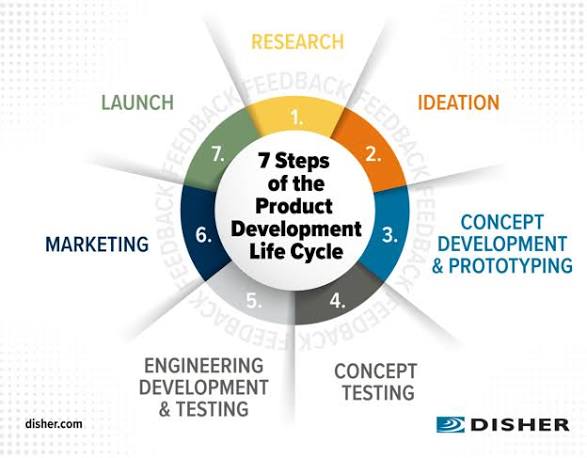Product Development Group
IDEA' s & INVENTION STRATEGIES IN MOTION
Issues - Strategies - Solutions - Resources
GATEWAY
Product Development Overview
The product development process is a structured method for bringing a new product to market, typically involving idea generation and screening, concept development, business analysis, prototyping, testing, commercialization, and launch.
This dynamic process involves constant collaboration among teams, using feedback and iteration to refine a product from its initial concept to a successful market release that addresses customer needs.
Here are the key steps in a common product development process:
Idea Generation: Brainstorming and identifying innovative ideas to solve a customer problem or meet a market need.
Idea Screening: Evaluating and filtering ideas to identify the most promising ones.
Concept Development & Testing: Developing the best ideas into detailed product concepts and testing them with potential users to gather feedback.
Business Analysis: Assessing the financial viability of the product, including costs, market demand, and profitability.
Prototyping & Design: Creating detailed designs and building a working prototype or sample of the product to test functionality.
Testing & Validation: Conducting thorough testing to ensure the product meets quality and performance expectations and aligns with customer needs.
Commercialization & Launch: Developing a strategy for production and marketing, and then introducing the final product to the market.
Post-Launch Improvement: Continuously gathering customer feedback and iterating on the product to drive improvements and identify new opportunities.
The product development process is a structured, multi-stage journey that transforms an idea into a market-ready product. It is an iterative and cross-functional effort that includes teams from departments such as engineering, design, marketing, and sales. A consistent process helps companies reduce risks, increase efficiency, and ensure that the final product meets customer needs.
The typical stages of the product development process
While specific methodologies vary, most product development follows a similar progression of key stages.
1. Ideation
This is the brainstorming phase where you generate new product ideas to address customer pain points or market opportunities.
Sources of ideas: Ideas can come from customer feedback, competitor analysis, internal teams, or emerging market trends.
Techniques: Frameworks like the SCAMPER method can help re-envision existing products by asking if they can be Substituted, Combined, Adapted, Modified, Put to another use, Eliminated, or Reversed.
2. Screening
Once you have a list of potential ideas, you evaluate them to filter out those that are not feasible or don't align with business goals.
Evaluation criteria: Ideas are typically scored based on factors like market size, technical feasibility, and overall impact.
Analysis: Tools like a SWOT analysis can help you identify an idea's strengths, weaknesses, opportunities, and threats.
3. Concept development and testing
During this phase, you refine a promising idea into a more concrete and detailed concept.
Detailed design: This includes defining the core value proposition, features, and specifications for the product.
Concept testing: You can then present the concept to potential customers to gauge interest and gather initial feedback.
4. Business analysis
This stage is where you determine if the product is financially viable and will be profitable in the marketplace.
Financial projections: This involves mapping out financial forecasts, including development costs, potential revenue, and pricing strategies.
Market analysis: You will analyze the market to confirm demand and ensure that the product can achieve a viable profit margin.
5. Prototyping
A prototype is a preliminary, working version of the product created to test its functionality and user experience.
MVP: A Minimum Viable Product (MVP) is a specific type of prototype that has just enough features to satisfy early customers and gather feedback for future iterations.
Internal testing: Prototypes are tested by internal teams to identify flaws, improve performance, and enhance usability.
6. Validation and testing
This involves putting the product through rigorous real-world testing before a full-scale launch to ensure it's ready for the market.
Beta testing: A beta version of the product is released to a limited external group for real-world feedback on performance and usability.
A/B testing: For digital products, A/B testing can compare different versions to see which performs better.
7. Commercialization and launch
Once the product is validated and refined, it is prepared for public release.
Launch strategy: This involves finalizing the go-to-market plan, including branding, messaging, pricing, and distribution.
Marketing campaigns: The marketing and sales teams activate campaigns to generate awareness and demand.
8. Evaluation and iteration
The process doesn't end at launch. This final stage involves tracking product performance and using feedback to plan for future improvements.
Feedback analysis: Collect and analyze customer feedback, sales data, and performance metrics to identify areas for improvement.
Lifecycle management: Use these insights to create future updates and manage the product throughout its life.
Methodologies for product development
Companies can employ different methodologies to manage the product development process.
Agile: An iterative and customer-centric approach that breaks development into short cycles called "sprints." It focuses on adapting to change and delivering continuous value.
Pros: High flexibility, faster time-to-market, and reduced risk due to frequent testing and feedback loops.
Cons: Can have less predictability in terms of cost and timeline, and requires intense team communication.
Lean: A methodology that prioritizes minimizing waste and maximizing customer value. The focus is on a continuous cycle of building, measuring, and learning.
Pros: Highly efficient, reduces waste, and uses rapid feedback loops to prevent costly feature overload.
Cons: Can be challenging to implement in large organizations due to a need for a significant culture shift.
Waterfall: A traditional, linear process where each phase must be completed before the next one begins. It is best suited for projects with stable, well-defined requirements.
Pros: Predictable, with clearly defined deliverables and milestones, making it easier to track progress.
Cons: Very rigid and not well-suited for adapting to changes or incorporating feedback after a phase is completed.










